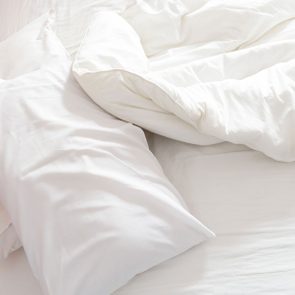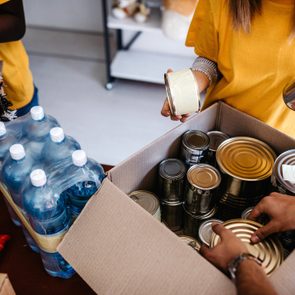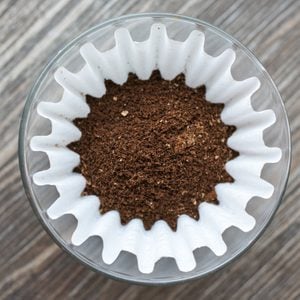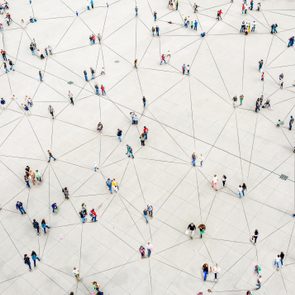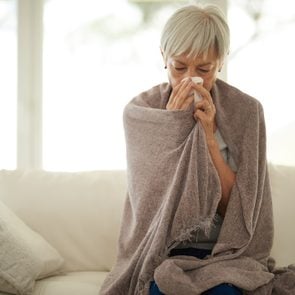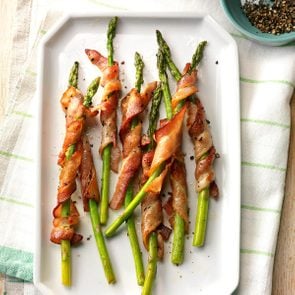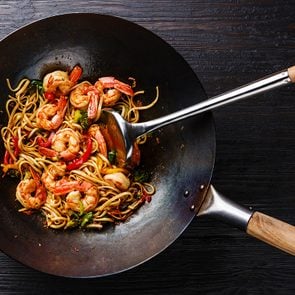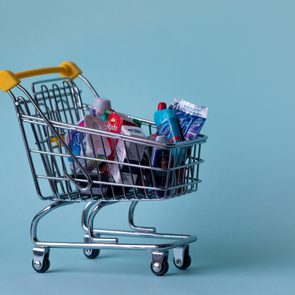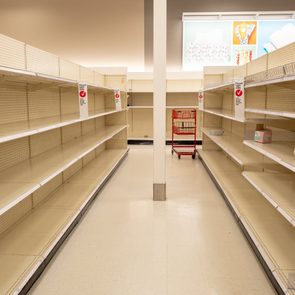Due to the coronavirus pandemic, washing your dishes properly is more important than ever. We’re all doing the most we can to stay healthy, which makes basic tasks like dishwashing even more crucial. If you’ve recently been wondering whether you should be doing the dishes by hand or use a dishwasher, we asked an expert and found out the answer for you.
When doing the dishes, stick to a dishwasher
If you currently own a dishwasher, you’re in luck. Dishwashers are the most efficient way to keep your dishes clean, according to Sean Parry, director at domestic cleaning and housekeeping service, Neat Services. “The key difference between hand washing and using a dishwasher is the water temperature,” says Parry. “You probably use cool or lukewarm water during a typical dish-rinsing routine. That’s nowhere near the heat necessary to make dishes truly bacteria-free. Our hands just can’t take the hot water temperatures (140 or 145 degrees Fahrenheit/60 or 63 degrees Celsius) that many dishwashers use to get stuff really clean.”
Of course, what dishwashers can do goes beyond resisting hot temperatures. “Modern dishwashers often include an increasing number of high-tech features that are just better at cleaning than we are—the design of the racks, the spray of the water jets and other aspects have been tailored to improve performance,” says Parry. “However, in the past, this wasn’t necessarily the case. Old dishwashers didn’t get dishes very clean unless you pre-washed. For new dishwashers, that is no longer an issue. Almost all of them have what’s called soil sensors. Depending on how dirty the dishes are, they will wash more or less.”
This is pretty impressive in itself, but here are 15 other things you didn’t know your dishwasher could do.
The kitchen sponge issue
Another reason why using a dishwasher is more hygienic is the issue of the kitchen sponge. While it might not seem like it at first glance, the kitchen sponge is a haven for bacteria. In fact, an average kitchen sponge was found to contain 45 billion bacteria per square centimetre, according to a 2017 study published in Scientific Reports. (Here’s exactly how to clean a kitchen sponge.)
“The kitchen sponge has been proven time and time again to be one of the germiest items in your home, if not the germiest item in your home,” says Parry. “So when you combine this with using lukewarm water, you can quickly see how hand washing can be nowhere near as hygienic as using the dishwasher.”
Dishwashers are more environmentally friendly
You’ll probably be happy to know that in addition to being the more hygienic choice, using a dishwasher is also more environmentally friendly. Washing dishes by hand uses three and a half times as much water as a dishwasher, in addition to being more energy- and time-consuming, according to a 2018 study by Reviewed.com.
Parry also backs up this point, adding that over the years, dishwashers have grown more energy and water-efficient. Next, find out the dishwasher problems you should never ignore.
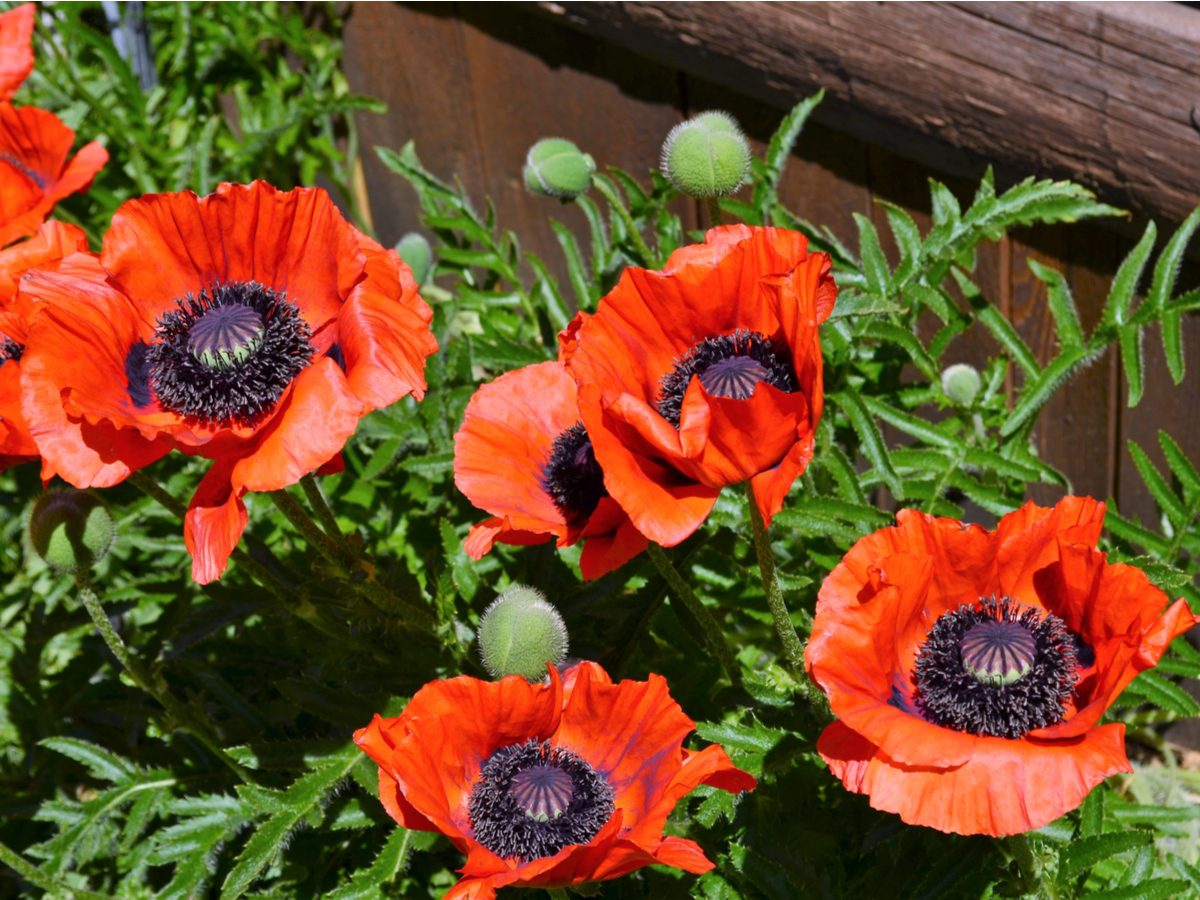
The Flower Thief
I am the flower thief of Vancouver. I’ve been a predator of beauty all my life, and beauty has had many faces.
As a child of the ’50s, beauty was a plum tree glistening purple, with dripping sap, cracked plums and ecstatic yellow jackets circling my semi-naked monkey body as I clambered through the branches, somehow unstung, filling my T-shirt with the sweet, sticky crop from the tree.
At first, my predations were mostly gardens, though I did branch out into comic books and chocolate bars until my ruthless, righteous mother caught me. Oh the shame of being marched down to the local convenience store and abjectly apologizing while I paid everything back.
My crooked ways soon returned. I was an incorrigible child. We discovered the old lady’s carrot patch down the street. We would crouch in her garden and yank the tender young carrots out, rub them clean and munch them down like Bugs Bunny before running, shrieking for our lives when the cane-wielding old lady appeared.
This was followed by the discovery of the watermelon farm. How I miss those seedy, ineffably sweet watermelons, along with the cow corn we ate raw, also sweet, only starchy. I miss smashing the stolen melon with my bare fist, scooping out the red flesh. I miss the seed-spitting contests in the shade by the creek. Then, in the summer heat, leaping into the rushing, clean water, clothes and all. Today, both creek and field are potentially toxic, while the new hybrid watermelons have lost their teeth-hurting intensity.
One day, we kids were raiding the ancient man’s garden across the street. He grew the best raspberries. Suddenly, the man came hobbling out the door wielding a broom and I scurried home. He followed me to my door—and then inside! My parents were at work. I was terrified, so I slithered under their bed as he stalked through the rooms, grumbling and waving his broom. He shoved it under the bed where I was hiding, just missing me. Fortunately, he couldn’t manage to lean down far enough to see me. He left the house, slamming the door, cursing his way home.
My nefarious instincts returned again when I was a student at Simon Fraser University. A lovely woman had joined me at my home in White Rock and, while walking the beach road, I noticed a row of enormous sunflowers growing alongside a shed.
That night I returned with a knife, hacked off the largest head and kept it in a jug on the kitchen table. The sunflower impressed the lady, though a few days later the guilt crept in and has stuck with me ever since, almost 50 years. The more I took to my own gardening, the more I regarded myself as a crud, especially since I’ve never been able to grow a sunflower as large as that regal, stolen giant.
By 1980, I had become almost too obsessed with gardening. Cultivating a garden made me a fierce protector of my plants, along with those of my neighbours and public gardens, too.
Then came the brutal July of 2015. I lost my health to one of those ferocious hospital bacterias. I also lost the love of my life, who changed her mind about me after 38 years. We had to give up our farm paradise on Salt Spring Island, with its orchard and large garden that I’d dream-fantasied into existence when I was 17 years old.
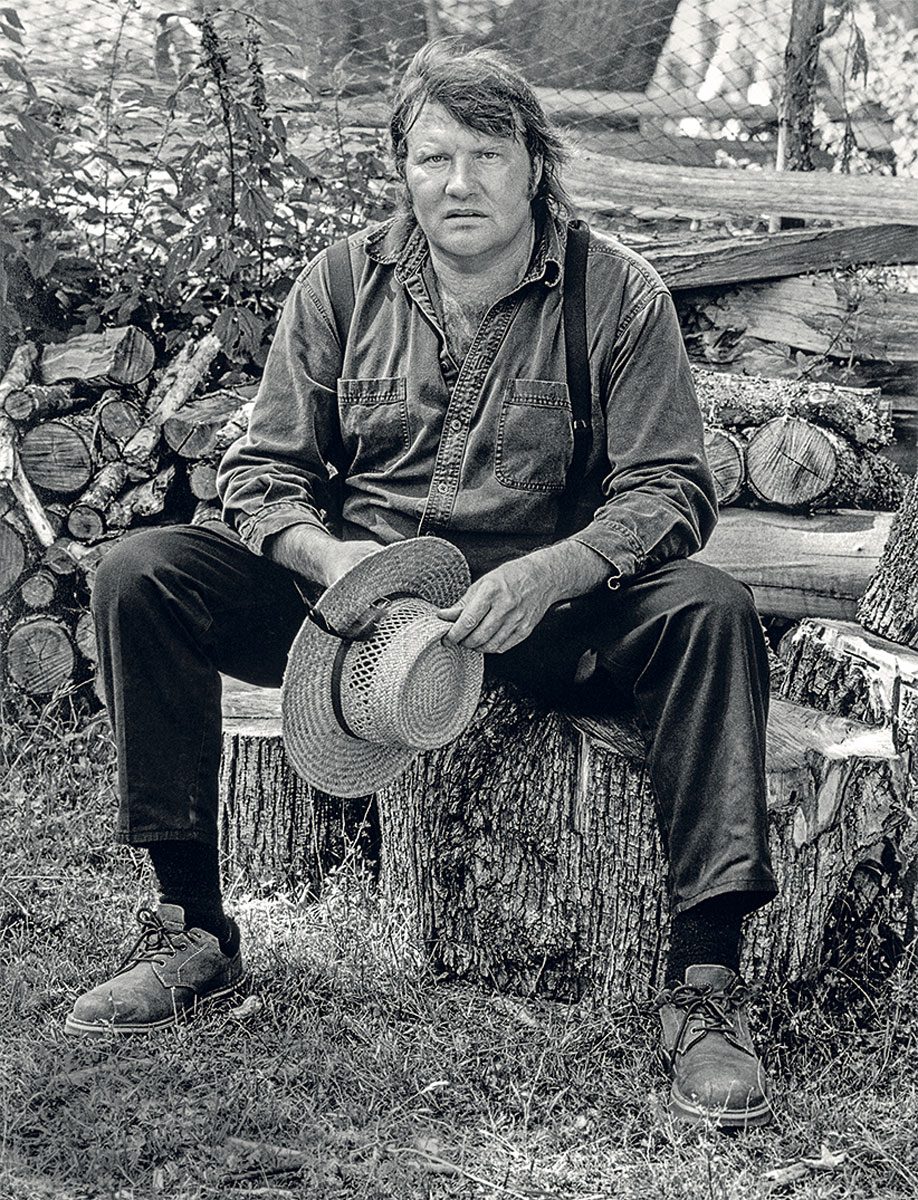
In February 2019, once again a lowly renter in Vancouver, my new surgeon told me I was too far gone to operate on a newly diagnosed liver cancer. I had less than a 50 per cent chance of surviving the year. Not that I believed him, but the thought of being shut down so suddenly made me consider the possibility that it was my last spring.
I walked out of that doctor’s office, angry at his rude dismissal, then recognized how blue the sky was. It hadn’t been that blue since I was 12 years old, when I scratched “There are 287 kinds of blue” on the back of my clothes dresser, along with the name of a pretty young girl I knew in Grade 6, so that neither would be forgotten. And they weren’t, though the dresser is long gone.
What a weird spring we had in 2019, such a crazy unleashing of blossoms. I realized I had to pay attention to every one of them. Then my heart specialist decided to compete with my oncologist for the role of Doctor Doom. She told me that my chances for another spring were even slimmer.
My last flowers! The deranged flower prowler was unleashed. At first I nabbed them mostly with permission from people’s yards, or off the boulevards. My bedroom became thick with magnolias, camellias, quince and crabapple. My brightest spring ever.
I still believed I was unkillable, though I suspect everyone thinks that when they receive the death penalty. I continued on my raids. I know that snatching flowers is a cruel thing to do, but I also knew what I was doing, so the pruning was very artful.
Also, in a further plea for leniency, I generally stuck to the public boulevards. While the city has some brilliant arborists, it clearly doesn’t have enough staff to properly prune everything, so I tidied up the trees as I snatched the blossoms. You may call this vigilante pruning or, more artistically, guerrilla ikebana.
This is not something the average idiot with a hacksaw should practise. Pruning is a complex business. For instance, I sterilized my pruning shears in between trees so I didn’t pass any disease from one tree to another.
As I carried out my forays, I thought of a quote attributed to Buddha: “Attention leads to immortality. Carelessness leads to death. Those who pay attention will not die, while the careless are as good as dead already.”
I thought, too, of what the good Dr. Johnson said: “When a man knows he is to be hanged in a fortnight, it concentrates his mind wonderfully.”
That’s why I became enamoured of the two splendid camellias that grow in my yard. Many centuries back, an intrepid Japanese gardener noticed that certain camellias faded, even as they bloomed. Rather than breed them to correct that flaw, he bred to enhance it so that his fellow citizens would understand the transience of life and death’s presence, even in these elegant, near-perfect blossoms.
It never occurred to me that so many flowers would soon clutter the house. Since there were already orchids at my bedside, the room had grown crowded very quickly. (I kept the orchids so that if I should die in my sleep, they will be the last things I see when I extinguish the lights.) This beautiful dilemma was worsened by my kitten, who discovered that vases full of quince, cherry, plum, camellia, roses and peonies made for excellent batting practice.
And yet, I went out for more. If a particularly spectacular flower was in a yard, I would ask someone at the door for a cutting. Even those who don’t speak English figured me out quickly, with my pruning shears and my pantomimes pointing at a branch. They invariably nodded yes.
Only one person turned me down. I trudged up to a door and knocked, and could see through the curtains a large man and a woman snuggled up on the sofa, watching TV. They never moved. So I knocked again. She rose and walked to the window by the door, pulled the curtain aside, stared at me and then returned to the sofa.
This so inflamed me that I chopped off a dangling branch of her beautiful magnolia as I returned down the sidewalk. Now I feel guilty about that one. She might have been harassed by a local gang or was a frightened refugee; there could have been any reason for her rudeness.
I took early evening walks to map out the best flowers. When the light faded, I dashed in and had at them like Edward Scissorhands, turning some bedraggled hawthorn or Magnolia liliiflora Nigra into a beauty before fleeing with my ill-gotten gains.
I should receive a good citizenship award for donating my decades of pruning skills to the city for free, but I’ll probably get arrested for writing this article.
Vancouver is noted worldwide for its exquisite public trees. Some of them have a complex history. For example, Vancouver’s original 500 sakura, or cherry trees, were a gift from the mayors of Kobe and Yokohama, who wanted to express their gratitude to the Japanese-Canadians who served in the First World War. Unfortunately, we repaid them 10 years later by interning all Japanese residents in prison camps.
Now there are around 20,000 cherry trees in multiple varieties planted among magnolias and plum and hundreds of other trees.
Looking up the history of my local trees made reality return with a vengeance, and I realized with some horror what I had been doing, so I set down my pruning shears again. “O mother tell your children not to do what I have done!”
Treat our city of gardens with respect. Save the flowers for your children. Yes, pay attention!
Me? I was rewarded with a new diagnosis of survival for an extra year.
Though another spring is here, no longer will I prowl our evenings, pruning shears in hand, even though my damaged heart is exploding like a deep red rose.
Stolen beauty has a special, dangerous quality. It’s also a destructive quality, never as special as natural beauty admired in its natural place. Our real duty is to bloom and grow bright, then fade and die.
Next, read the inspiring story of Verna Marzo—given only a sliver of a chance at survival, she is now an amputee marathoner.

Grey hair, don’t care
My mom hated my white hair. She hated it when it first sprouted in my early twenties. She hated it six years later when I too busy raising a small child to keep up with covering my increasingly silver roots. And she really hated it when, years later, I finally decided to let it grow out.
I was in my 30s when I first started to truly get fed-up with my hair-dye routine. Twice a year, I’d splurge for a salon to professionally dye my hair, but within a few weeks, I was back to needing a top-up. To help save my bank account, I’d then grab the cheapest box of dye on the shelf and dutifully slather its contents on my head. Still, I’d see white roots within two weeks. And, because I often grabbed whatever was on sale, even when I kept up the schedule my head was a random mix of sable, chicory and a dozen other names for “brown.”
I began to strategically style my hair with colourful headbands. I used a kind of hair paint to touch up my roots, even though it never quite matched my actual hair colour. I discovered a love for hats.
At one point, I bought the blackest black dye I could find, thinking I could at least reset my locks to a single colour. Instead, I stained my forehead charcoal. I walked around that way for weeks before it faded. After, I thought: that’s it. I refused to buy another box of cheap dye, and decided that if I really wanted a do-over, I was going to get back to my natural hair first—even if it meant embracing the grey.
Meanwhile, my mother was in her mid-fifties and three decades into her own Clairol pledge. Her hair was dyed jet black, and like many women in the Calgary South Asian community I grew up in, she believed grey hair meant she had given up on being attractive. “What will people think?” she’d ask me, glaring at the curly, grey rebels wending their way through my dark hair in growing numbers, “That I have jet black hair and my child is going grey?”
I’d respond by pointing to a photo of her mother, my Nanni. In India, women commonly disguised the age of their hair. Once they became widows, however, they were expected to look the part. After her husband died, Nanni wore her hair in a single, snow-white plait that ran halfway down her back. She was only in her 40s, but she loved her white hair. With it, she was no longer expected to wear bright saris and makeup, or to endure the catcalls of men as she walked outside. To her, white hair symbolized freedom.
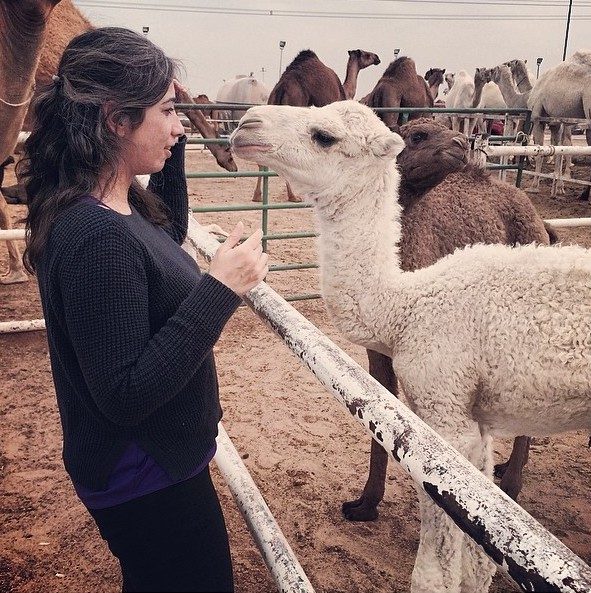
It took two years to fully grow out my hair dye and let my true grey shine. I’m now 45, and like my Nanni, I love my hair. The white strands on my head do not follow the crowd. My brown hair stays calmly in the pins and elastics I assign it. Not so for their rebellious melanin-lacking counterparts. My white hairs stand straight up, curl around my ears and generally cause as much disruption to my hairstyle as they are able. They’re the feminist leaders of my otherwise tamed mane.
Today, women of all ages openly admire my hair, expressing their wish to be “brave enough” to walk away from the bottle. I understand their fear. As much as people compliment my hair, many others negatively associate it with age. Now that my white hair has migrated to my eyebrows, every visit to the aesthetician comes with a side of advice on how easy it is to dye them. But I let go of my own fear a long time ago. Now, whenever someone offers to “fix” my greys, I smile and let them know that I like looking my age.
My advice to you is: have fun with it. Buy a funky hat—or buy a dozen. Try a thick headband or repurpose a silk scarf. Embrace the roots. Cut off your dyed hair and try a full-silver pixie cut. Or, be even more daring.
I grew up envious of blondes and their ability to morph with ease. Simple lemon juice could turn their heads shimmery white; a dab of colour and their heads became works of art. My white hair now gives me a freedom of expression I never had with dark hair. I recently discovered a product that temporarily turns my grey into a whole range of fun colours. I’ve since had a rainbow flow from my imagination to my locks, from blue to red to purple to green. After a week or two, my hair returns to its true salt-and-pepper state—and I love that too.
Thanks to COVID-19, most of the world is now living in self-isolation. That means no salon trips to cover the grey and, for some of us, no easy access to boxed dye either. Instead of stressing over your roots, why not use this unprecedented moment to take the plunge and allow your own grey to gain ground? My hope is that more than a few will unexpectedly discover a newfound freedom in going grey. Now can be the moment when simple practicality gives a boost of courage to those who need it—and perhaps makes society just a little less judgmental when they see us all sporting our new grey tresses.
By the way, my mom now sports a head full of pure snow-white hair—not grey, not silver, but pure white. As she watched my transition over the years, it gave her the courage to walk away from the dye. Welcome to the pack mom, I can’t wait to rock that look.
Next, check out a barber’s advice for Canadians who are considering cutting their own hair during self-quarantine.
According to the latest recommendations from government medical agencies, it’s highly recommended—and in some instances, mandatory—to wear a face mask that covers your nose and mouth when you’re in public. This includes going to the grocery store or pharmacy, riding public transit or any other time you’re not able to maintain the recommended social distancing of at least two metres. Doing so should help slow the spread of the novel coronavirus. (Here’s what you can do to reduce your risk of catching COVID-19 on public transit.) Luckily, creating your own DIY face mask out of a few ordinary household items couldn’t be easier.
All you need is a 20-by-20-inch cotton bandana or a tightly woven piece of cotton (a t-shirt, pillow case or tea towel can also be cut to size), two hair ties (or rubber bands), and a coffee filter. Simply follow the instructions in the video below to make your own.
What you’ll need to make a DIY face mask:
- Bandana or cotton fabric, approximately 20-by-20 inches
- Coffee filter (or piece of HEPA vacuum filter)
- 2 hair ties (or rubber bands or pieces of elastic)
Step-by-step instructions to make a DIY face mask:
- Fold the bandana in half.
- Fold the coffee filter in half and place in the centre of the folded bandana.
- Fold the bottom third of the bandana up, then fold the top third of the bandana down.
- Loop one hair tie around each end of the folded fabric. They should sit about 6 inches apart.
- Fold each end of the fabric in towards the centre and tuck them into each other.
- To put on the mask, loop the hair ties over your ears. Adjust the mask to make sure it covers your nose and mouth completely.
Helpful hints:
- To remove your DIY face mask, lift from the hair ties (or rubber bands). Avoid touching the fabric at the front of the mask. Discard the coffee filter after each use.
- Wash the bandana (or cotton fabric) with hot water and detergent. Allow to dry thoroughly.
- Remember to wear your DIY face mask every time you head to the grocery store—and don’t forget about physical distancing—to help slow the spread of coronavirus.
Now that you know how to make a DIY face mask, find out how to maintain social distancing as Canada reopens.
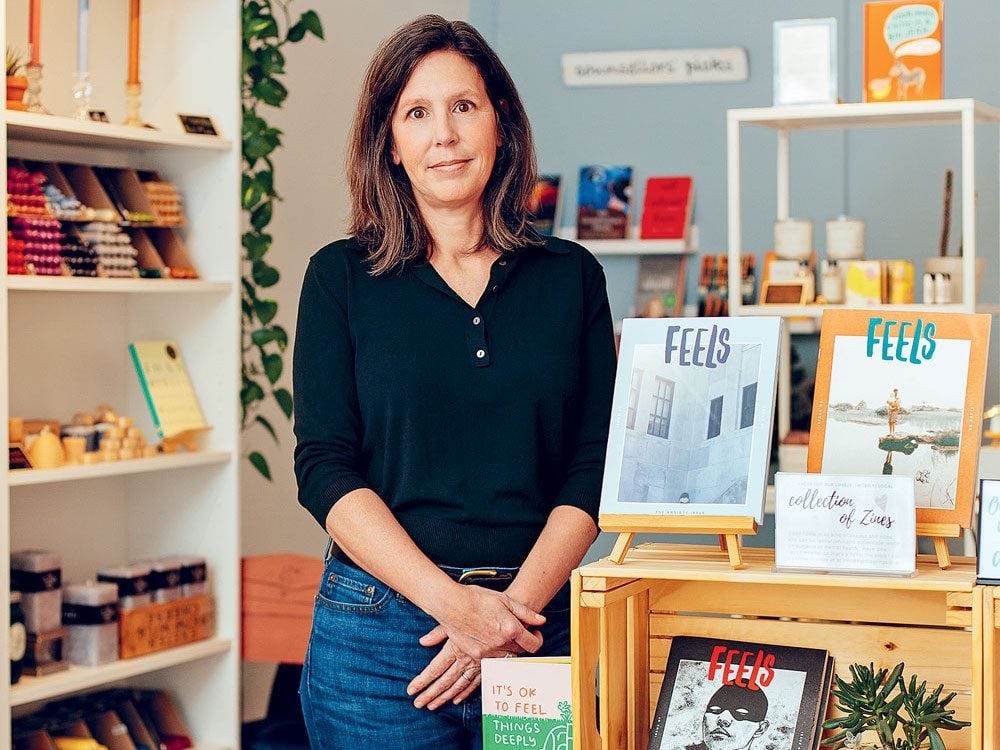
Talk shop
From the street, Hard Feelings looks more like an independent bookstore than a mental health centre. Shelves are lined with books on trauma, gender and sexuality, parenting and more. You can buy candles, notebooks, teas and mugs. But past the cheery receptionist wait three rooms reserved for counselling sessions.
Kate Scowen opened Hard Feelings in Toronto in 2017. Therapy in Canada can be prohibitively expensive for low-income and gig economy workers and anyone else without workplace benefits. Scowen wanted to fill the gap by making a difference, not a profit.
Scowen wasn’t new to helping others. Over almost 30 years, she held various jobs assisting marginalized youth, and taught English to community work students at Toronto’s George Brown College. At age 49, after a lifetime of practical experience, she enrolled in the graduate social work program at the University of Toronto. It was during her studies that she landed on a plan to open her own counselling centre.
According to recent reports from Statistics Canada, more than five million Canadians reported needing mental health care, but nearly half of that group said their needs were either unmet or only partially met. Often, people go without because they can’t afford care or don’t know where to get it. That is where the Hard Feelings model—a storefront anyone can access—fits in. “I wanted to develop something based on my ideal of how mental health supports could be offered,” says Scowen, “and that is with community, warmth and innovation.”
Scowen recruited nearly 30 counsellors who treat a wide range of mental health issues, including anxiety, depression, substance abuse and anger management. In its first year, the clinic served 342 clients. Last year, that number jumped to 424. Clients are charged between $50 and $80 per session; the exact fee is decided during the first meeting and based on ability to pay. In comparison, therapists elsewhere in Toronto often charge up to $125 per session, putting help beyond reach for many people.
The emphasis is on short-term counselling—a max of 12 sessions. Scowen says this guarantees more people can access their services. (If longer term treatment is required, a client and counsellor may agree to continue at the counsellor’s private practice.) The point, though, is to tear down barriers to mental health care. Her counsellors all happily accept lower hourly rates just to be involved, and dozens have joined a waiting list to offer therapy at the centre.
While clients come from all over the city, many live or work in the neighbourhood, which is one of the city’s most economically and ethnically diverse. Some walk in off the street, attracted by the friendly window displays and curious to learn more. With the spread of COVID-19, clients have also wanted to talk about challenges with stress, often because of job loss. Many are freelancers, gig workers or retail staff who were laid off or saw their income sources dry up during the outbreak.
Many clients also feel like they’ve found something special. When Max Mertens, a 29-year-old freelance journalist, was laid off in early summer 2018, he was wracked with anxiety. He recognized he needed counselling but also knew he was unable to afford it. Then he discovered Hard Feelings. “It really helped,” he says, “to have a place to vent for an hour.” After his 12 sessions were finished, Mertens continued seeing his therapist. Hard Feelings is an amazing place, he says. He only wishes there were more like it.
Next, learn about the bootcamp that helps retired seniors launch new businesses.
Battling coronavirus is an experience that will forever be etched in my mind. I had what’s considered a mild case, but even in its weakest form, this virus is brutal. Now that I’ve recovered, I’m sharing my story because I want people to take this situation seriously. Others won’t be so lucky to face coronavirus head-on and come out the other side alive. To turn things around, we have to stay home. We have to fight this battle together—and we have to win.
Where it all began
My boyfriend and I have been trying to trace our steps back to where we first came into contact with coronavirus, and we think it was the night we went out to celebrate his sister-in-law’s 40th birthday in early March. We went to a Mexican restaurant on Long Island that Friday night, and we shared lots of laughs and food. We took turns placing our straws into this mega margarita, passing it around the table.
We didn’t think anything of it at the time, of course. The news was just beginning to report the spread of COVID-19 in America, so it wasn’t exactly at the forefront of my mind. I was still living my life just as I always had—riding the train to work each day, working long hours, going out with friends and family, and, yes, sharing margaritas. Sharing food and drinks is one of the everyday habits that could (and should) change forever after coronavirus.
Looking back now, I think that must have been the start of it all. My boyfriend, Luis, began showing symptoms on Monday, but we assumed it was a typical cold. He works from home, so we figured it would just blow over. He had body aches and a minor fever for five days, but it didn’t seem a cause for concern. Then it took me down.

Working in the midst of chaos
I worked for a home-textile company at the time, and even though news about coronavirus was all around us, we continued to work as usual. In fact, we received twice as many deliveries from China that week, as its factories were back up and finally running again. People in the office began to get something that seemed like a cold virus, but most of them still kept coming to work.
My symptoms began on Monday, March 16. It had been a week since Luis had been sick. It all began with a low fever, about 99 to 100 degrees. I felt really weak, but I still went to work. By the day’s end, I told my boss I had to leave. At this point, coronavirus had begun to take over New York, so I was told to work from home. On Tuesday, the headache started. It was so intense that I had to lie down—it was too difficult to keep my head up. The pain was mainly behind my eyes, like a very heavy sinus headache.
From bad to worse
By the end of the week, I knew something was off. This wasn’t what a typical illness felt like. Everything hurt. I felt a bit disoriented, and the headache became debilitating. Luis and I decided it was time I seek medical help. My fever was only 100.6 degrees, but it felt like my skin was being pulled in opposite directions. That’s when I got really scared. My knees, hands, and even my earlobes hurt. My entire body tingled like it had fallen asleep.
We went to nearby urgent care, where I filled out paperwork and waited for the doctor. After examining me, the doctor said he was certain I would test positive for coronavirus, but gave me the option to test if I wanted to know for sure. He was confident that I’d contracted it from Luis. I opted to be tested, but I didn’t receive my results until a week later.
After the fact, I learned that quick results are only given at the hospital. The test consisted of the doctor putting a very long cotton swab as far up my nose as possible—it felt like it went to my forehead. He sent me home with advice to take Tylenol but said there was nothing more he could do for me. He also stressed the importance of staying hydrated. On the way home, we bought whatever Tylenol we could find at the store.
Finding medication, along with many other essentials, is difficult right now—which makes things extra hard for the people who really need it. Here are more reasons why panic buying isn’t actually helpful.

The peak
That Saturday evening was the absolute worst. My fever spiked to 101.8 degrees, and I couldn’t sleep. I was sweating profusely, and my knees, hips, and back were in excruciating pain. It was as though I had run a marathon that I never trained for. I couldn’t shake it. I lost my sense of taste and smell, which led me to over-seasoning my food in the hopes that I could taste something. It didn’t work. Then I developed stomach pain and diarrhea. Oddly enough, the dry cough I developed only arrived at the very end. My symptoms were reversed, according to most of the anecdotes I’ve heard about the novel coronavirus.
As I lay there, just trying to survive each day, my fear of having to go to an already overwhelmed hospital was palpable. I was terrified that I’d be forced to seek help and that there wouldn’t be enough doctors, nurses, ventilators, or beds to help me. I was scared that there was no cure and no vaccine. The thought of being alone, and possibly dying alone, in the hospital, weighed heavily on my thoughts. I didn’t know how much worse I was going to get, and I feared the uncertainty of it all.
My fever finally broke the following Wednesday. I went to bed that night, and the next morning I awoke to a perfect 98.6-degree temperature that remained consistent. It was such a relief. Two days later, the health department called me with the news that I’d tested positive for COVID-19. By then, I was feeling mostly back to myself again, except for a lingering dry cough.
What I wish I’d known earlier
Looking back, I really wish that people had taken this virus more seriously earlier. In New York City, we all live on top of one another, and even just taking the train to work is exposing us. I wish people understood how severe this is, even when you get a “mild” case, like mine. I know a lot of doctors are talking about possibly having immunity after contracting the virus, but I’m still wearing a mask in public from now on. While we don’t know if it’s at all possible, I don’t want to catch this again. I’m not taking chances. I know they say the media blows things out of proportion, but that’s not true with this. This was really painful, and we got lucky.
Next, find out what other people infected with coronavirus want you to know.
Building a case for the 20-minute exercise
A 20-minute exercise may sound more like a warm-up than a workout, but a 2017 study published in Brain, Behaviour, and Immunity suggests otherwise. Researchers found that as little as 20 minutes of exercise can have anti-inflammatory effects that boost your immune system. They specifically monitored the effects of one 20-minute session of moderate treadmill exercise, but senior author Suzi Hong, PhD, in the department of psychiatry and the department of family medicine and public health at UC San Diego School of Medicine, says, that fast walking appears to have similar effects.
In the study, 47 participants first gave a blood sample before exercising. Then, they walked on a treadmill for about 20 minutes—with the intensity adjusted for each person’s fitness level—then provided another blood sample immediately after. The blood samples showed that the exercise caused a five per cent decrease in the number of immune cells producing a cytokine, or protein, called tumour necrosis factor—TNF. (More on TNF later.)
Here’s why that’s important: Exercise activates the sympathetic nervous system, a pathway that increases heart rate, blood pressure, and breathing rate. When this happens, the hormones epinephrine and norepinephrine are released into the bloodstream and activate a cellular reaction that suppresses cytokines, including TNF.
TNF has some admirable qualities, like boosting immune responses and killing cancer cells, but it also has pro-inflammatory properties. Though inflammation is a necessary part of our immune systems, too much of it can lead to autoimmune diseases, including rheumatoid arthritis and multiple sclerosis, as well as fibromyalgia.
Why and how exercise can reduce inflammation
Previous research has already demonstrated that exercise can reduce inflammation, but the significance of this study is in the physiological explanations about why and how this happens, says Carmen Terzic, MD, PhD, chair of the physical medicine and rehabilitation department at the Mayo Clinic in Rochester, Minnesota.
Moderate exercise also has an abundance of other health benefits, like controlling hypertension and diabetes, preventing Alzheimer’s, reducing anxiety and stress, and slowing the aging process. Dr. Terzic says that people who engage in moderate exercise regularly can increase their lifespan by up to 10 years. “Exercise is our best medicine for almost every single disease you can think of,” she says.
The best part? Light to moderate exercise is as simple as taking the stairs instead of the elevator. Or, it can even be spending a few more minutes walking your dog. That’s right—no gym membership required.
Next, check out these simple habits to naturally boost your immune system.
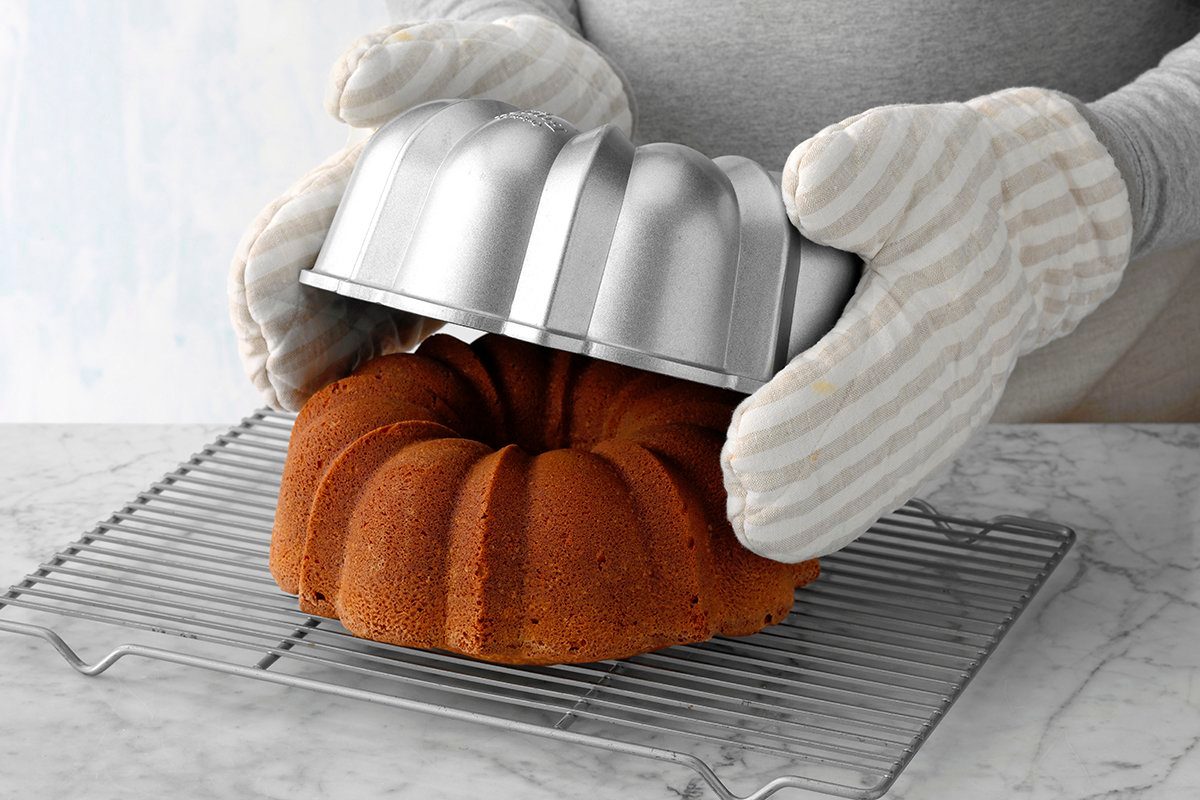
Everyone loves a beautiful Bundt cake. They look absolutely stunning and they’re much less work than a layer cake. As easy as Bundt cakes are to stir up and bake, there’s always some stress that comes along with taking one out of the pan. All the grooves and designs in those pretty Bundt pans can make getting your cake out of there in one piece a challenge. But our Test Kitchen’s Bundt expert Catherine Ward has lots of tips on how you can get your cake out in one piece and looking perfect.
First things first: Grease your Bundt pan properly
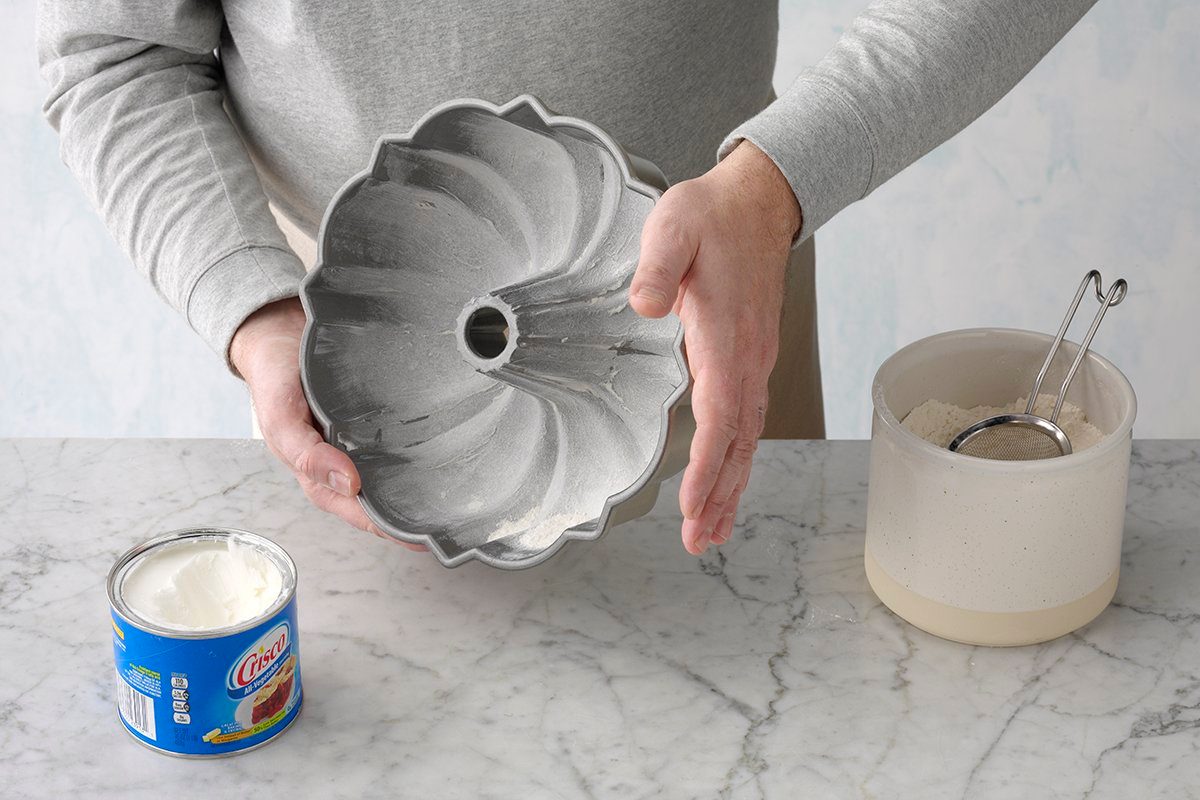
The best way to ensure your cake comes out of the pan cleanly is to grease it well from the start. Catherine and our Test Kitchen staff always use shortening to grease Bundt pans—yes, even ones with nonstick coating.
To grease a Bundt pan, take a dollop of shortening on a paper towel and wipe the interior of the pan. You want to get into every nook and cranny. Then dust with flour and tap away the excess. “You don’t want any clumps,” Catherine says. If you see any misses, just regrease and flour again.
If you’re making a chocolate Bundt cake, swap out the flour for cocoa powder. It’ll help your cake retain its rich chocolate colou
r (flour can make it look a bit pale).
Test Kitchen tip: Don’t use butter to grease your pan. The milk solids in butter can cling to the pan and cause your cake to stick.
Cool before flipping
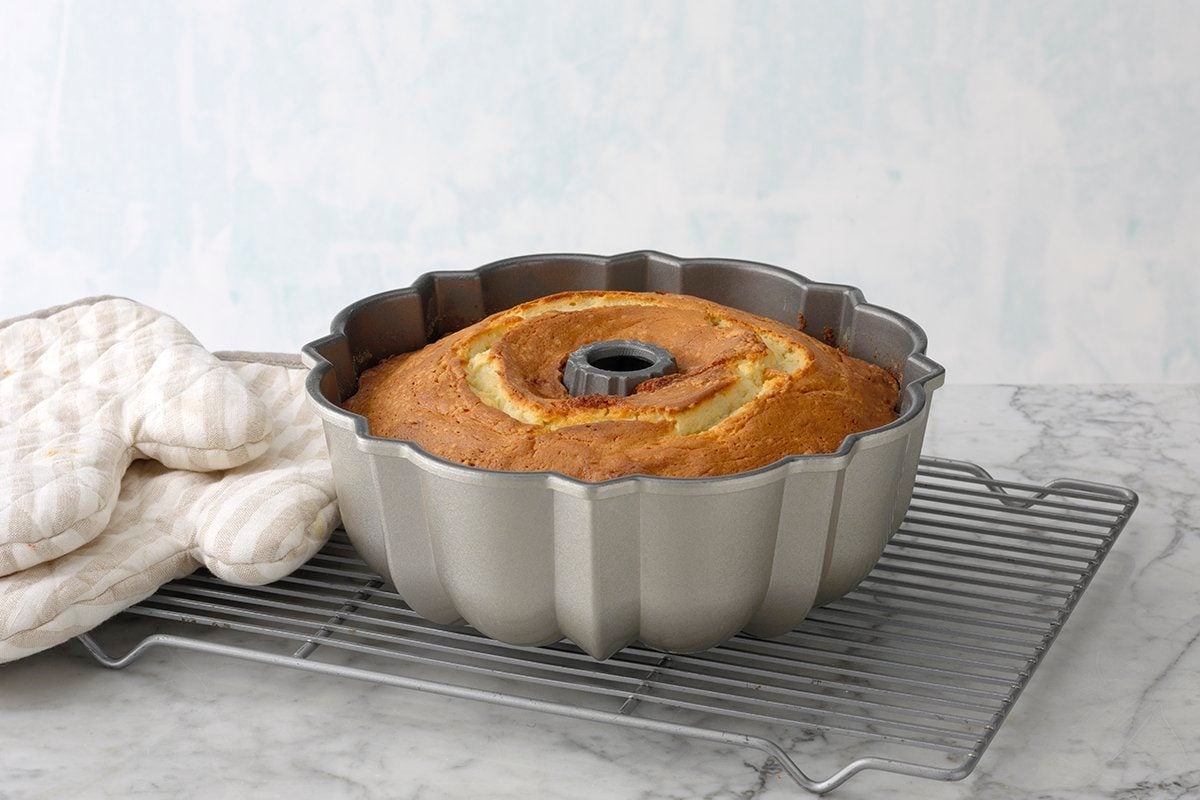
When you remove your cake from the oven, don’t flip it out of the pan right away! Instead, let the cake cool for ten minutes in the pan. Then, placing the wire rack over the base of the cake, invert the pan.
Peek under the wire rack and see if the cake has dropped out. If it has, wonderful news! Remove the pan and let the cake cool completely.
Cake not coming out? Give it a bang
If the cake doesn’t immediately come out of the pan after turning it over, there’s no need to stress. “Just give it a bang,” Catherine says.
That’s right: Lay a dishtowel on your countertop and (gently) bang the edges of your pan. This can help loosen up the cake from the sides of the pan. Sometimes fruits can stick to the pan. They just need a little encouragement to release.
No luck? Let gravity do its job
When turning and tapping don’t work, all that’s left to do is let gravity do the work. “Just flip it and let it sit,” according to Catherine. “Check on it after five to ten minutes.”
During that time, the cake has a chance to cool, contract and release from the pan.
Hiding imperfections
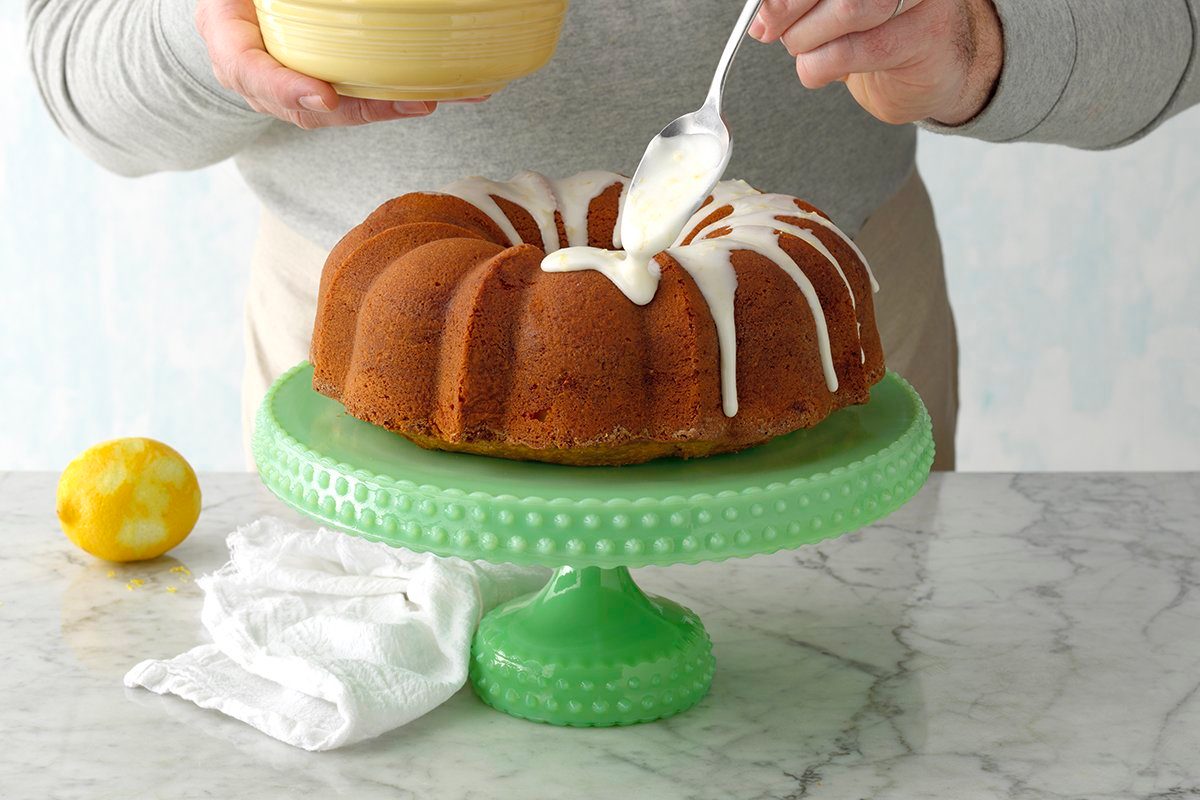
Despite our best efforts, sometimes Bundt cakes just don’t come out all in one piece. It’s OK! It happens to the best of us.
If you find that just a small chunk (or a few chunks) of the cake is stuck, just patch it together while the cake is still warm. The heat and stickiness of the cake can bind it together. Disguise any imperfections with a simple glaze or icing.
But what if your cake totally stuck or is a big flop? “If your Bundt cake is a total fail, turn it into a delicious trifle,” according to Catherine. All you have to do is cube up the cooled cake and layer with cream, custard and fruit. No one will be the wiser and you’ll still have a tasty dessert.
Whether your cake comes out perfectly or is destined to become a trifle, Catherine has one big piece of advice: “Always serve it with pride.”
Preying on hope and fear
As the cases of coronavirus continue to grow, we’re all hoping to find a magical silver bullet (beyond social distancing) to help us avoid or combat the illness. Unfortunately, that can leave us vulnerable to con artists and price gougers, who pass off unproven or quack products as potential cures or ways to prevent coronavirus. Some of these “solutions” can even be flat-out dangerous. The bottom line is that COVID-19 is a new contagion, and scientists still have a lot to learn about it. There is no magical way to fortify your immune system to stave off infection or cure yourself, but hopefully someday soon, there will be a vaccine. So, think twice before you invest in these products, and instead, follow government guidelines to stay safe and healthy. And remember: Coronavirus is actually just one of a long list of diseases you can prevent just by washing your hands.
Colloidal silver
There’s absolutely no evidence that drinking colloidal silver (tiny bits of silver suspended in liquid) improves anyone’s health in any measurable way—or kills coronavirus or any other known pathogen. But that didn’t stop televangelist Jim Bakker from touting the product Silver Solution as a potential coronavirus cure on his TV show. Recognizing the danger in this, several U.S. state governments filed lawsuits against Bakker to get him to stop promoting this quack medicine. So, if “news” of this potential treatment for coronavirus makes its way onto your social-media newsfeed, don’t fall for it.
Sodium chlorite
The FDA recently posted a warning about drinking sodium chlorite, which may be sold as Miracle Mineral Solution or Master Mineral Solution. According to the warning, sodium chlorite is an active ingredient in many disinfectants, and it is dangerous to drink. It can cause side effects like nausea and vomiting, which some of the products’ proponents claim is a sign that they’re working. In reality, it’s just a sign that it’s making them dangerously sick—without any benefits in preventing or curing coronavirus.
Elderberry syrup
Some natural-health practitioners have suggested using elderberry syrup to help protect against or treat COVID-19. While is there is some evidence that this berry may help fight colds and mildly boost immunity due to its antioxidants and vitamins, there is absolutely no evidence that elderberry syrup can combat the coronavirus. In fact, the FDA has stopped at least one manufacturer from claiming that its elderberry products are helpful in dealing with this virus.
Superblue Toothpaste
Conservative radio host and known conspiracy theorist Alex Jones recently got a cease-and-desist letter from the New York attorney general regarding his claims that his Superblue Toothpaste “kills the whole SARS-corona family at point-blank range.” There is no toothpaste (or any other product out there) that can kill the coronavirus—yet.
Chloroquine
This potent drug, which is used to treat malaria, lupus, and rheumatoid arthritis, along with several other diseases, has shown some promise as a treatment for COVID-19. It’s one of several potential treatments being explored, including infusions of plasma from people who have recovered from coronavirus and the antiviral drug remdesivir. Experts, however, caution that more research is needed.
Unfortunately, the excitement about the potential of chloroquine has caused problems. One man in Arizona has already died from ingesting a version of chloroquine that’s used to clean aquariums, and several people in Nigeria died after overdosing on the medication. Here’s how people infected with coronavirus are dealing with it—and what they want you to know.
Tea
Social media has spread the idea that drinking tea can help cure coronavirus. This idea is usually attributed to Wuhan doctor Li Wenliang, the whistleblower who eventually died from the illness. While tea might help you feel better and stay hydrated, it won’t protect you from COVID-19. One silver lining: At least it’s a lot tastier than one of the other quack cures that are spreading around India right now—ingesting cow urine to fight against the illness.
Distilled white vinegar
Some social media posts have claimed that this common household product can kill the virus when you gargle it or use it to clean your home. Unfortunately, vinegar cannot help you in either instance. To actually kill coronavirus, use antiseptic wipes, bleach solution, or simple soap and water to clean surfaces. There’s nothing you can gargle to fight the virus, but warm salt water may help soothe a sore throat. If you stocked up before reading this, try these smart ways to put all that vinegar to good use.
Vodka
With hand sanitizer in short supply, many enterprising folks started sharing recipes for making their own at home. One recipe that spread like wildfire used Tito’s Vodka as the main ingredient. Unfortunately, hand sanitizer must contain at least 60 per cent alcohol to be remotely effective, and Tito’s Vodka straight up only has 40 per cent. As a result, the company launched a campaign to keep people from mixing up a batch of ineffective sanitizer with their vodka—and encouraged them to mix up a cocktail instead.
Red Cross home tests
Red Cross chapters across the country have had to warn against this coronavirus-related scam, where fraudsters come to your door and offer a free, at-home coronavirus test, courtesy of the Red Cross. The Red Cross is not offering any coronavirus tests at this time, so if someone tries this scam, you should lock your door and call the police immediately. Watch out for these other online coronavirus scams, too.
Vitamin C
High doses of vitamin C are being used as an experimental treatment for some New York coronavirus patients, reports Newsweek, so other people are now dosing themselves pretty heavily with the potent antioxidant. This has led to an increased demand for orange juice in some places and a surge in frozen concentrate orange juice futures in the commodity markets. However, drinking orange juice or taking vitamin C supplements at home will likely not provide any real benefits, according to Peter McCaffery, professor of biochemistry at the University of Aberdeen in the United Kingdom. “Taking large doses of vitamin C tablets would be very unlikely to protect you from COVID-19—unless you were actually vitamin C deficient, which with a normal diet is quite rare,” he told Newsweek. (Learn to spot the symptoms of a nutrient deficiency.)
Zinc
Zinc has shown promise against far-more-common coronaviruses, which can cause the common cold. As a result, people are stocking up on zinc supplements, and sales have risen more than 200 per cent, according to the New York Times. Unfortunately, though, there’s no evidence that zinc works for COVID-19, which is a very different type of virus from the cold viruses we’re used to. Plus, taking too much zinc can cause health problems like anemia and actually negatively impact your immune system, so don’t go overboard with it. Here are the silent signs of anemia you should never ignore. Next, find out how to avoid germs when grocery shopping.
